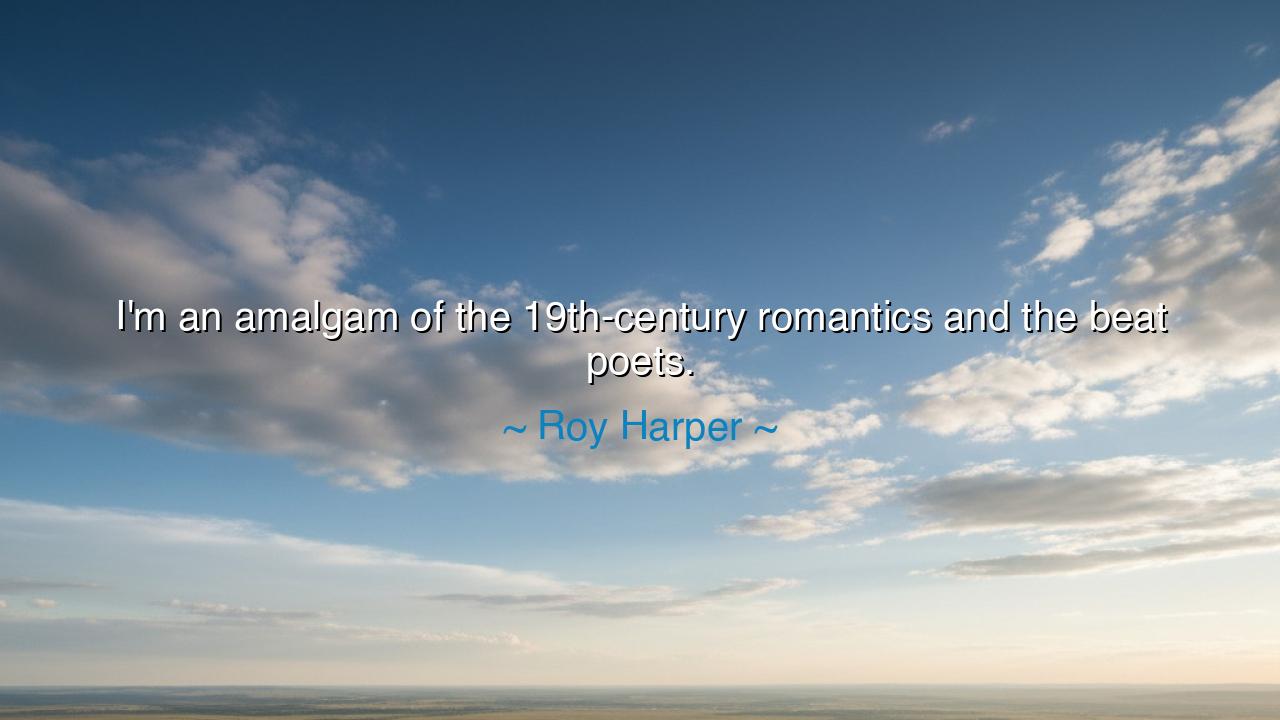
I'm an amalgam of the 19th-century romantics and the beat poets.






In the words of Roy Harper, "I'm an amalgam of the 19th-century romantics and the beat poets," we are introduced to a unique fusion of two rich literary and philosophical traditions that have shaped not just the way we understand art and poetry, but also how we perceive the human experience itself. Harper’s statement reflects a melding of the intense idealism of the romantic poets, with the raw revolutionary spirit of the Beat Generation. It speaks to the complexity of the artist’s soul, forged from centuries of longing, rebellion, and the pursuit of truth through expression.
The 19th-century romantics, exemplified by figures like William Wordsworth, Lord Byron, and Percy Bysshe Shelley, sought to elevate human experience to a level that transcended the mundane. The romantic movement emphasized the power of individual emotion, the sublime in nature, and the quest for freedom from societal constraints. Byron, for instance, embodied the romantic hero, a figure who rejected the conventions of his time in favor of passion and personal liberty. He lived a life full of contradictions—both the beloved poet and the outlaw, constantly at odds with the social norms of his age. Like the romantics, Harper embraces this spirit of individualism and emotional depth, where the soul’s journey is not just personal, but philosophical—a search for meaning in the vast expanse of human longing and connection.
Yet, Harper also draws from the Beat poets, a group of writers in the mid-20th century who rebelled against the conformity of post-World War II American society. Allen Ginsberg, Jack Kerouac, and William S. Burroughs were not only interested in literature, but in challenging the established norms of culture, politics, and consciousness. The Beat Generation was marked by a profound search for freedom, a rejection of the materialism that defined their world, and a deep commitment to self-expression and spiritual exploration. Ginsberg’s Howl, a raw and unflinching portrayal of human suffering and desire, became the emblem of the Beats' dedication to speaking the unfiltered truth, no matter how uncomfortable or controversial. In Harper’s words, we see a reflection of this rebellion—an embrace of emotional rawness and a desire to speak truthfully about the human condition, much like the Beat poets did in their time.
Harper’s fusion of the romantic and the Beat is not simply a blend of historical movements, but a living testament to the spirit of art itself. Art, at its core, has always been about expressing the inexpressible, about capturing the intensity of human experience and communicating that energy to the world. In the same way the romantics found beauty in nature and the sublime, and the Beats found it in the undercurrents of modern life, Harper seeks to reflect the essence of both worlds. To be an amalgam of these two powerful forces is to bridge the gap between idealism and rebellion, to express love and longing while acknowledging the darker realities of life.
This amalgamation also has roots in the ancient world, where poets like Homer and Virgil blended the heroic with the human. The Iliad and the Aeneid are both tales of grand adventure and personal transformation, where heroes like Achilles and Aeneas are not only defined by their courage, but also by their flaws, their internal struggles, and their deep emotional battles. These poets, like the romantics and the Beat poets, understood that the true essence of human life was found in the contrast—the tension between idealism and reality, between freedom and duty, between beauty and suffering.
The lesson Harper’s words impart is one of embracing contradiction and complexity in our own lives. To be romantic is not to idealize the world, but to understand its beauty while acknowledging its darkness. To be Beat is not to reject society in its entirety, but to seek a deeper truth—to strip away the layers of conformity and reveal the rawness of existence. Both philosophies teach us that life is not about living in one extreme or the other, but about finding meaning in the intersection of those extremes—the tension between passion and rebellion, between idealism and reality.
In your own life, embrace the complexity of the world. Seek out not just the ideal, but the truth that lies beneath the surface. Do not be afraid to rebel against the conventions that stifle your creativity and expression, but also do not forget to celebrate the beauty in the world that exists despite its flaws. Like the romantics, learn to appreciate the emotional depth of your own experiences, and like the Beat poets, refuse to accept the world at face value—dig deeper, explore beyond the surface, and seek the truth that can only be found through personal reflection and raw expression. In this way, you can become your own amalgamation, bridging the gap between dreams and reality, hope and rebellion, just as Roy Harper does in his artistry.






AAdministratorAdministrator
Welcome, honored guests. Please leave a comment, we will respond soon